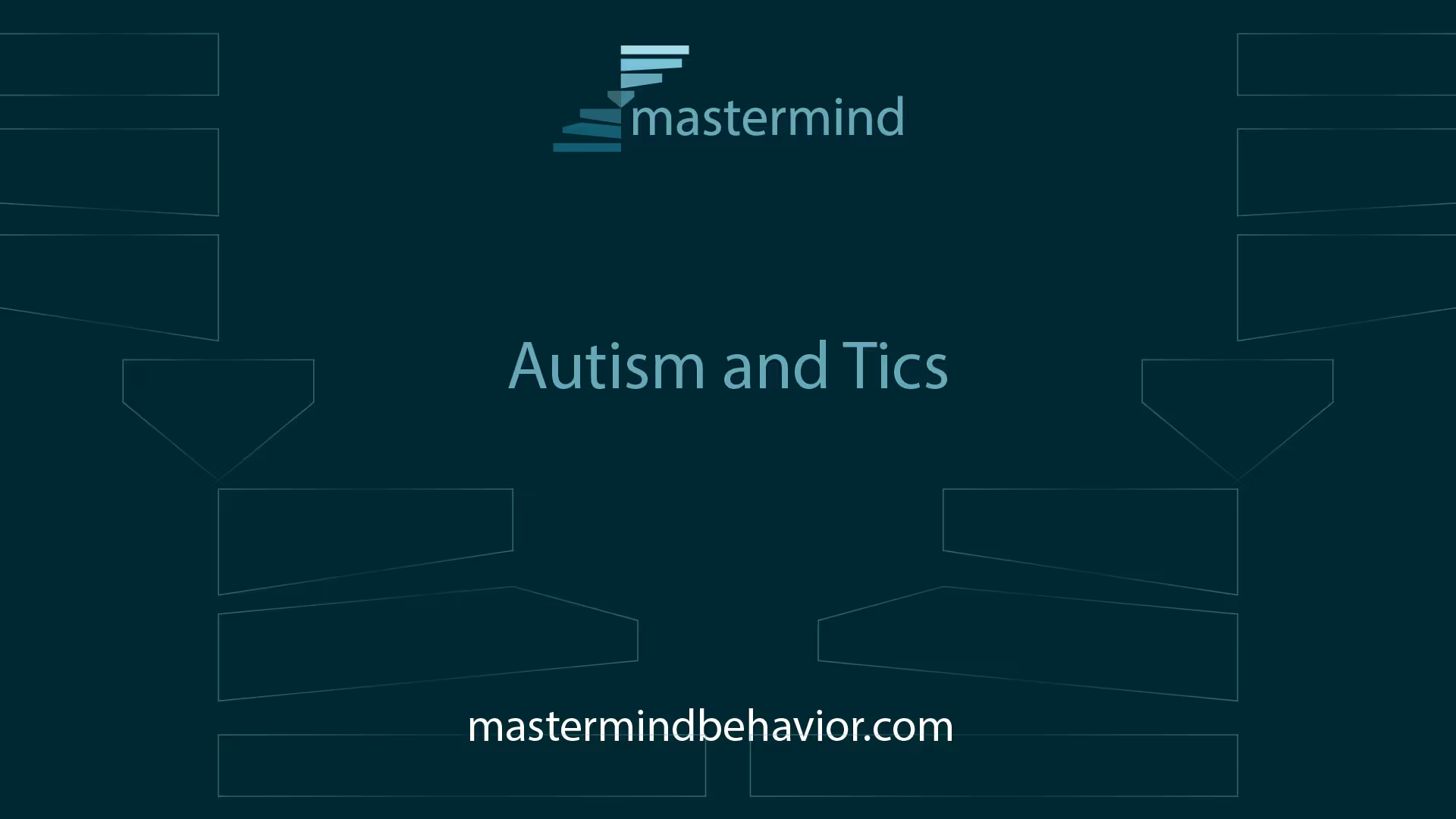Autism and Tics

Understanding Autism and Tics
The understanding of autism and tics is crucial for anyone seeking to gain an insight into how these two conditions interact. In this section, we will provide an overview of Autism Spectrum Disorder (ASD) and describe the characteristics of tics.
Overview of Autism Spectrum Disorder
Autism Spectrum Disorder (ASD) is a developmental disability that can cause significant social, communication, and behavioral challenges. This disorder is not a singular condition with a one-size-fits-all set of symptoms. Rather, it is a spectrum disorder, meaning it encompasses a range of conditions characterized by challenges with social skills, repetitive behaviors, speech, and nonverbal communication.
For individuals with ASD, social communication and interaction can be a significant challenge. This difficulty often manifests in restricted or repetitive behaviors and interests, setting ASD apart from conditions characterized solely by problems with social communication and interaction. The early identification of ASD is vital for providing the necessary resources and support to the child and their family, and it is a focal point of many organizations, including the CDC.

Characteristics of Tics
Tics are sudden, rapid, non-rhythmic movements or sounds that people do repeatedly. They can be motor (movement) tics or vocal (sound) tics, and they are classified as either simple or complex. Simple tics involve a small number of muscle groups and are brief and sudden. Complex tics involve multiple muscle groups and may seem purposeful and coordinated.
In the context of autism, tics often appear during early childhood, typically between the ages of 5 and 10 [2]. The most common age of onset for tics in children with autism is between five to seven years old, with the highest severity occurring between eight and twelve years of age. Common initial tics include facial movements, throat clearing, and eye blinking.
Understanding the characteristics of autism and tics is the first step in being able to recognize their symptoms and seek appropriate support and interventions. This understanding is also important for healthcare professionals, educators, and caregivers who work with individuals with ASD and tics. Through this knowledge, they can ensure that these individuals receive the understanding, respect, and care they deserve.
Connection Between Autism and Tics
Understanding the interplay between autism and tics is crucial for improving the management and treatment of these conditions. In this section, we will discuss the prevalence of tics in autistic individuals and how autism tics differ from those associated with Tourette's syndrome.
Prevalence of Tics in Autistic Individuals
Research indicates that tics are relatively common in people with autism. According to a 2016 study, around 9-12% of autistic individuals may experience tics. These tics often appear during early childhood, typically between the ages of 5 and 10.
It's important to note that the prevalence of tics in autistic individuals can vary depending on multiple factors, including the individual's age, the severity of their autism, and their overall health.
Differentiating Autism Tics from Tourette's Tics
While both autism and Tourette's syndrome involve repetitive behaviors, these conditions are distinct and their associated tics differ in several ways. Tourette's syndrome is a neurological condition characterized by motor and vocal tics, which are not the same as autistic tics [2].
Autistic tics are typically integrated into the individual's behavior and may be less noticeable than Tourette's tics. They may also co-occur with other autistic behaviors, such as repetitive movements or speech patterns.
Interestingly, researchers have found a strong overlap between Tourette’s syndrome and autism. In individuals with Tourette’s syndrome, approximately one in five children also met the criteria for autism, suggesting a strong link between the two conditions.
Understanding the differences between autism tics and Tourette's tics can assist clinicians in making accurate diagnoses and implementing effective treatment strategies. It's important to recognize that while there are overlaps, each condition requires a unique approach to management and care.
Onset and Development of Tics
Understanding the onset and development of tics in individuals with autism is crucial to providing appropriate and timely intervention. The age at which tics first appear and their progression over time can vary significantly among individuals.
Age of Onset for Autism Tics
Tics associated with autism often first appear during early childhood, typically between the ages of 5 and 10. On average, the most common age of onset for tics in children with autism is between five to seven years old, with the highest severity occurring between eight and twelve years of age. Common initial tics include facial movements, throat clearing, and eye blinking.
This period of onset aligns closely with the early stages of autism spectrum disorder, which often begins in early childhood and can cause challenges in functioning in society — socially, in school, and at work. The symptoms of autism often show within the first year of life, with a small number of children appearing to develop normally in the first year, and then going through a period of regression between 18 and 24 months of age when they develop autism symptoms.
Progression and Severity of Tics
The severity of tics is usually highest from around 8 years of age until the teenage years. They typically start to improve after puberty. While in most cases, tics gradually improve over time or cease completely, they can come and go over several years, with some lasting a few months [5].
However, it's important to note that the progression of tics can vary significantly among individuals with autism. Some children with autism spectrum disorder may have difficulty learning, and others may show signs of lower than normal intelligence. Yet other children with the disorder have normal to high intelligence — they learn quickly, yet have trouble communicating and applying what they know in everyday life and adjusting to social situations.
In understanding the onset and progression of 'autism and tics', it's essential to remember that each individual's experience is unique. Therefore, the approach to managing and treating tics should be personalized to meet the needs of the individual.
Interventions for Autism Tics
Managing tics in individuals with autism requires targeted and personalized interventions. This section focuses on two key intervention strategies: behavioral therapy and the role of early intervention.
Behavioral Therapy for Tics
Behavior therapy is an evidence-based intervention that has demonstrated moderate-to-large treatment effects in reducing tic symptom severity among individuals with Persistent Tic Disorders (PTDs) and Tourette’s Disorder (TD). It has been successful in reducing tic severity for individuals with PTD in Randomized Controlled Trials (RCTs) and can serve as a standalone intervention or an augmentation strategy to existing pharmacotherapy. As such, professional organizations have recommended behavior therapy as the first-line intervention for youth with PTD who have mild-to-moderate tic severity.
Several studies have explored novel treatment delivery modalities to increase access to and availability of behavior therapy. This includes intensive behavior therapy treatment protocols and telemedicine approaches. Other professionals, such as physical therapists, have also begun to explore the possibility of conducting behavior therapy for PTD [6].
However, while behavior therapy offers significant tic reduction in the majority of cases, some challenges remain that can obstruct its regular utilization as a first-line intervention for individuals with PTD. These challenges include concerns regarding possible negative consequences of behavior therapy, limited accessibility and availability, limited therapeutic response to behavior therapy, and limited treatments targeting other problems encountered by individuals with PTD.
Role of Early Intervention
With the right interventions and support, many individuals with autism can experience a decrease in the severity of their tics over time [2]. Early intervention plays a crucial role in this process.
A 2020 study detailed the success of the Comprehensive Behavioral Intervention for Tic Disorders (CBIT) when adapted for use in young children, emphasizing the importance of early intervention in conditions like Tourette syndrome that may be comorbid in autistic children [2].
Digital Health Interventions (DHIs) have also shown promise in delivering tic therapies. Five trials aimed at reducing tic severity in children, young people, and adults using digital or remotely delivered therapy have shown the clinical utility of these interventions. They are considered clinically efficacious compared to an active control.
These digital and remote behavioral therapies have the potential to address the lack of access to behavioral treatments for people with tic disorders, a pressing issue worldwide. They show good adherence and engagement and are acceptable to patients. The role of human support, including therapists and parents for young people, is also likely to be important in encouraging adherence.
One study even found that internet-delivered behavioral therapy for tic disorders had similar efficacy but lower costs compared to face-to-face therapy, with therapists requiring limited training and delivering therapy in less time. These interventions highlight the importance of early and accessible interventions in managing autism and tics.
Research on Autism Tics
Diving into the research aspect of the subject, numerous studies have been conducted to understand and manage the occurrence of tics in individuals with autism.
Studies on Tic Suppression
A significant body of research has focused on understanding tic suppression, or the ability to control or suppress the involuntary movements or sounds that characterize tics. A 2019 study, for example, examined tic suppression in children who had recently started exhibiting tics. The study found that, even after only a few months of having tics, children were able to effectively suppress them, especially when they were given an immediate reward for doing so Autism Parenting Magazine.
This research suggests that behavioral strategies aimed at rewarding tic suppression could potentially be effective in managing tics in individuals with autism. However, more research is needed to understand the long-term effectiveness of these strategies and how they can be best implemented in different contexts.
Digital Health Interventions for Tic Therapies
In recent years, there has been a growing interest in the use of digital health interventions (DHIs) for delivering tic therapies. These interventions often involve the use of technology, such as smartphone apps or online platforms, to provide therapeutic interventions for individuals with autism and tics.
Five trials have been conducted aimed at reducing tic severity in children, young people and adults using digital or remotely delivered therapy. The evidence supports the clinical utility of DHIs for delivering tic therapies, showing promise in being clinically efficacious compared to an active control.
These digital and remote behavioral therapies have the potential to address the lack of access to behavioral treatments for people with tic disorders, which is a pressing issue worldwide. Furthermore, DHIs in trials show good adherence and engagement and are acceptable to patients, and the role of human support (including therapists and parents for young people) is likely to be important to encourage adherence.
One study even found that internet-delivered behavioral therapy for tic disorders had similar efficacy but lower costs compared to face-to-face therapy, with therapists requiring limited training and delivering therapy in less time.
These studies highlight the potential of DHIs for delivering tic therapies, but further research is needed to optimize these interventions, determine the best ways to implement them, and understand their long-term effectiveness in managing tics in individuals with autism.
Genetic and Neurological Factors
The relationship between autism and tics is a complex one, with genetic and neurological factors playing key roles. The development of tics often points to a dysfunction in the brain's chemistry and genetics, particularly in relation to dopamine and the basal ganglia region of the brain.
Dopamine Imbalance and Tics
Research has found that tics often arise due to an imbalance in brain chemicals, particularly dopamine, within specific regions of the brain such as the basal ganglia [3]. These areas of the brain are crucial for controlling movements and when imbalances occur, it can result in involuntary tics.
Tics are neurological conditions, not mental illnesses, and are characterized by changes in the brain area that controls movement [8]. A dysfunction in dopamine, a neurotransmitter that helps regulate movement and emotional responses, is believed to contribute to the development of tics.
Genetic Links Between Autism and Tics
While tics and autism are distinct conditions, they share some common genetic and neurodevelopmental characteristics. Tics are highly genetic in nature and often appear in individuals with a family history of tic disorders. Similar to tics, autism is a neurodevelopmental disorder that has been linked to genetic factors.
Moreover, an imbalance in brain chemicals within specific regions of the brain, such as the basal ganglia, has been identified in both tic disorders and autism. This commonality suggests a potential genetic link between autism and tics, and further research is needed to fully understand the connection.
Understanding the genetic and neurological factors that contribute to autism and tics can help healthcare professionals develop more effective intervention strategies and therapies. By studying these factors, we can gain a better understanding of why tics occur in individuals with autism and how to effectively manage these symptoms.
References
[1]: https://www.cdc.gov/autism/signs-symptoms/index.html
[2]: https://www.autismparentingmagazine.com/what-are-autistic-tics/
[3]: https://carmenbpingree.com/blog/tics-and-autism-whats-the-connection/
[4]: https://www.mayoclinic.org/diseases-conditions/autism-spectrum-disorder/symptoms-causes/syc-20352928
[5]: https://www.nhs.uk/conditions/tics/
[6]: https://www.ncbi.nlm.nih.gov/pmc/articles/PMC4629635/
Recent articles

How to Support Peer Relationships for Children with Autism
Building Bridges: Fostering Peer Connections in Children with Autism

The Benefits of Community-Based ABA Therapy for Social Skills Development
Fostering Social Integration and Independence in Children with Autism

How ABA Therapy Helps Build Daily Living Skills in Children
Empowering Independence: The Transformative Role of ABA in Children's Daily Skills

The Role of Collaborative Goal Setting in ABA Therapy Programs
Enhancing Outcomes Through Teamwork in ABA Therapy

How In-Home ABA Therapy Encourages a Natural Learning Environment
Creating Comfort and Confidence in Home-Based Autism Support

Understanding the Impact of Co-Occurring Conditions on Autism Treatment
Navigating Complexities: How Co-Occurring Conditions Shape Autism Interventions


